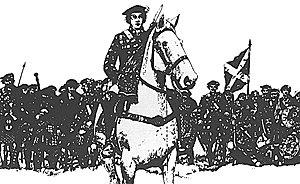 The Stuart hopes for restoration rested with troops raised in Scotland
and the army that fought in the last battle of the Jacobite Cause was drawn
largely from the clans of the West and Central Highlands as well as from
the Lowland areas in the Northeast (Banff, Aberdeen and Perth). Although
there were many Jacobite sympathizers in England, few were willing to risk
their properties and lives until it became clear that the Jacobites had a
chance to win. Accordingly, the only English participation in the Forty
Five was a small regiment raised in Manchester (300 men) during the
Prince's march to Derby. This unit was left behind at Carlisle during the
retreat to Scotland and abandoned to its own fate.
The Stuart hopes for restoration rested with troops raised in Scotland
and the army that fought in the last battle of the Jacobite Cause was drawn
largely from the clans of the West and Central Highlands as well as from
the Lowland areas in the Northeast (Banff, Aberdeen and Perth). Although
there were many Jacobite sympathizers in England, few were willing to risk
their properties and lives until it became clear that the Jacobites had a
chance to win. Accordingly, the only English participation in the Forty
Five was a small regiment raised in Manchester (300 men) during the
Prince's march to Derby. This unit was left behind at Carlisle during the
retreat to Scotland and abandoned to its own fate.
Contemporary estimates of fighting manpower in the Highlands varied from 20,000 to 30,000 men, and had all the clans rallied to the Prince's standard, then his march on London might have had a different outcome. As it was, the Jacobite army never exceeded 8,000 (stiortly after Falkirk). Estimated army strength was 1,000 at the Raising of the Standard at Glenfinnan; 2,500 at Prestonpans; 5,500 for the invasion of England; 8,000 at Falkirk; and 5,000 at Culloden. The Jacobites never did enjoy universal support in the Highlands. Clan Campbell and its chief, the Duke of Argyll, could raise 3,000 men-at-arms against the Prince. In the far north, the Munro, Ross, Sutherland and Mackay clans supported King George II with a combined strength of 2,000 men.
Jacobite manpower derived from four sources: (1) the Highland clan levies, (2) feudal or hereditary levies such as the Athol] Brigade, (3) true volunteers and (4) Scots-Irish expatriots in French military service.
More Jacobite Army At Culloden
- Introduction
The Clan System and Other Units
Jacobite Artillery and Cavalry
Weapons and Highland Battle Tactics
Jacobite Order of Battle
Jumbo Map of Battle of Culloden (very slow: 247K)
Back to Seven Years War Asso. Journal Vol. VI No. 4 Table of Contents
Back to Seven Years War Asso. Journal List of Issues
Back to Master Magazine List
© Copyright 1993 by James E. Purky
This article appears in MagWeb (Magazine Web) on the Internet World Wide Web.
Other military history articles and gaming articles are available at http://www.magweb.com